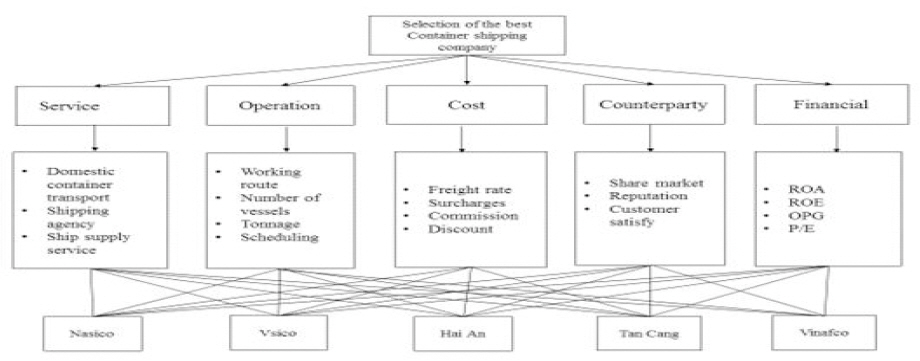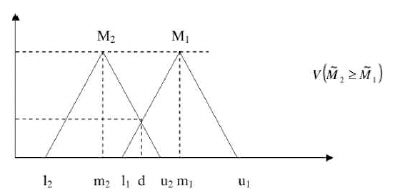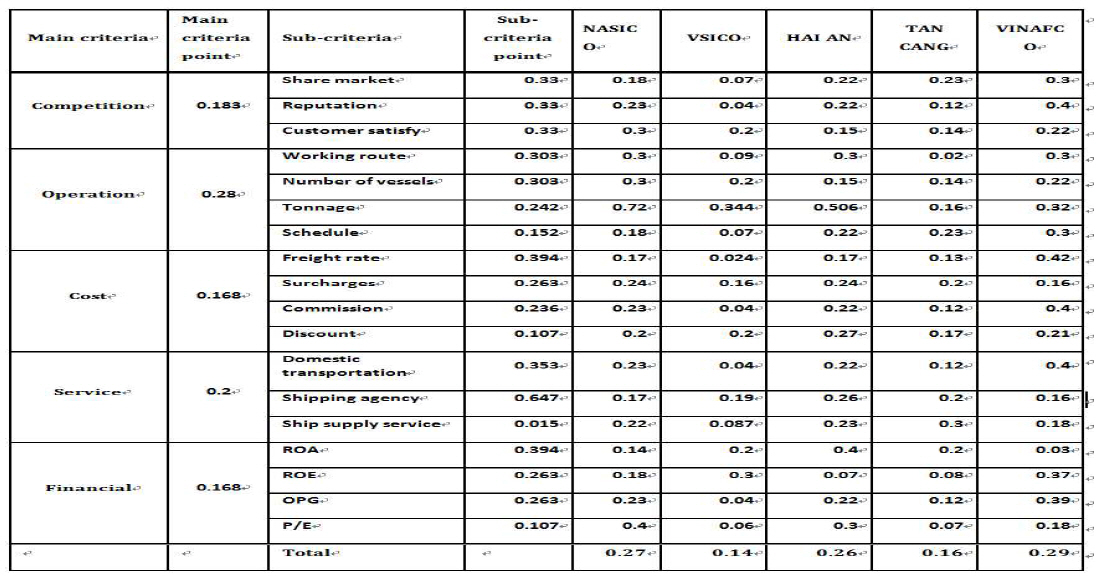Fuzzy AHP Evaluation for Performance of Container Shipping Companies in Vietnam (Developing on the Model of Previous Study for the Domestic Lines)
Article information
Abstract
Currently, container transport services play a substantial role in global cargo transportation, by serving as an intermodal between exporter and importer. Container shipping has become increasingly important over the past few decades, due to obvious advantages. However, Vietnam’s container market has shown severely ongoing competition among numerous domestic and foreign shipping lines, resulting in serious consequences occurring such as freight rates substantially decreasing within the last 10 years. Vietnam’s sea lanes have become more defensive, to cover losses of shipping companies. Selection of criteria for competitive evaluation of container transport companies is necessary, to facilitate addressing the problems within the enterprise, especially relating to its position in the market and from here, business management can implement strategic plans and reasonable policy, to survive and grow.
1. Introduction
Determining the most suitable container transport service provider is an important problem to deal with when managing supply chain of a company. It is vital in enhancing the competitiveness of the company and has a positive impact on expanding the life span of the company. In addition, the right choice will help customer achieve the quality of the best transport service, which help customers save costs, achieved the desired business result. The container shipping selection is a multi-criteria problem which includes both quantitative and qualitative criteria some of which can conflict each other.
Nowadays, selection of transport providers becomes complicated due to multiple suppliers, multiple conflicting criteria, and imprecise parameters. In addition the uncertainty and vagueness of the experts’ opinion is the prominent characteristic of the problem. For this reason the use of Fuzzy-AHP methods to determine the shipping company that the best quality.
The research builds a questionnaire to identify those criteria that are currently applied by shipping lines and Fuzzy AHP approach is applied in this research to show the weight of each criterion in the shipping liner feature category. The results were distributed again in a second questionnaire which is sent to the experts and academics in the field to highlight the basic criteria from their own perspective. Finally, the results of both questionnaires are given weight for each criterion through the Fuzzy-AHP method of analysis and the results were applied on the actual data each company. (Ngo, 2016a and 2016b)
2. Factors on the operation of the container shipping company
2.1 Service cost
Service cost by sea is one of the important links in the supply chain of services so with every customer, freight rates are always the top criteria for choosing container transport provider.
Shipping costs, which are composed of many different components costs and are divided into types of costs: costs of transport, loading and unloading fees, storage costs, costs of customs and port charges, packing charges, including transportation charges accounted for the highest proportion of about 58% of the total cost, 21% handling fee, storage fees accounted for 10%, 8% packaging fee, port charges and customs fees 3%.
2.2 Operation performance
The most obvious factor affecting the supply of container shipping services is the operation performance of the container-carrying fleet. In the shipping industry it is customary to categorize planning decisions by their time horizon. Strategic planning spans several years, tactical planning cover months while operational planning deal more with the day to day decisions. The fleet size and mix problem is usually defined as a strategic planning decision.
The larger the fleet, the fiercer competition and vice versa, assuming that demand does not change. Looking at the development of the number of vessels and the actual TEU capacity for fully containerized ships, the trend towards increasing vessel size becomes clear, as TEU capacity increased to a larger degree than the number of vessels.
2.3 Service cost
Service quality is an important precondition for an efficient development of all transport companies as a whole. There exist different types of liner services constructed to serve the demand in the different types of routes. The services are constructed to be profitable for the operators of the line and attractive for its customers.
Service of shipping include domestic container transportation, International container transportation, shipping agency and ship supply services.
2.4 Financial performance
Nowadays shipping market is a highly competitive industry operating under a dynamic changing environment. It is important for shipping companies to continuously improve their performance in order to maintain their current and future competitiveness, especially for container shipping companies, as they usually need an operation, thus financial performance directly influences the survival of a shipping company. Because of the large capitals demand, the shipping companies should evaluate their fi nancial performance to enhance the future finance ability and realize the competition location.
Financial performance has long been regarded as the core of a company, especially by those in top management level, in accounting aspect traditional evaluation method financial ratios are commonly classified into several categories. It includes Debt ratio, Time Interest Earned, Working capital ratio, Total assets turnover ratio and Gross profit ratio. Table1
2.5 Competition
For a long time, researches explain the need for ship-owners to avoid competition among themselves such as share market, reputation, and customer satisfies. The above reasons stood as an obstacle to conceptualizing the application of the perfect competition model in our sector: hence, it was a matter of common sense to state that, if liner carries were to compete among themselves for pricing, this would produce “rate wars” and a “destructive competition” whose consequences would undermine the stability of trade. Given the importance of having reliable and constant shipping services carrying goods traded in world markets, not only was cartelization accepted, but it was even welcomed in many instances as the most effective organizational model for container shipping. (Ngo, 2016a and 2016b)
3. Theoretical foundation
In 1965, Lotfi A. Zadeh proposed a new approach to a rigorous, precise theory of approximation and vagueness based on generalization of standard set theory to fuzzy sets. Fuzzy sets and fuzzy logic are powerful mathematical tools for modeling: uncertain systems in industry, nature and humanity; and facilitators for common-sense reasoning in decision making in the absence of complete and precise information.
Fuzzy numbers are the special classes of fuzzy quantities. A fuzzy number is a fuzzy quantity M that represents a generalization of a real number r.
Intuitively, M(x) should be a measure of how well M(x) “approximates” r (Nguyen & Walker 2000). A fuzzy number M is a convex normalized fuzzy set. A fuzzy number is 53 characterized by a given interval of real numbers, each with a grade of membership between 0 and 1 (Deng, 1999). A triangular fuzzy number (TFN), M is shown in figure 3.1:
Triangular fuzzy numbers (Table 3.1) are defined by three real numbers, expressed as (l,m,u). The parameters l, m, and u, respectively, indicate the smallest possible value, the most promising value, and the largest possible value that describe a fuzzy event. Their membership functions are described as;
In this study the extent FAHP is utilized, which was originally introduced by Chang (1996).
Let
Where Mjgi(j = 1, 2, ..., m) all are TFNs. The steps of Chang’s extent analysis can be given as in the following:
1. The value of fuzzy synthetic extent with respect to the i th object is defined as:
To obtain
And to obtain
And compute the inverse of the vector above
2. As M1 = (l1,m1,u1) and M2 = (l2,m2,u2) are two triangular fuzzy numbers, the degree of possibility of M2 = (l2,m2,u2) ≥ M1 = (l1,m1,u1) defined as:
And can be equivalently expressed as follows:
3. The degree possibility for a convex fuzzy number to be greater than k convex fuzzy Mi(i=1, 2, k) numbers can be defined by
Fig. 2 illustrates Eq. (8) where d is the ordinate of the highest intersection point D between μM1 and μM2 to compare M1 and M2, we need both the value so fV(M1≥ M2) and V(M2≥M1).
4. Via normalization, the normalized weight vectors are
Where W is a non-fuzzy number.
Application of F-AHP methodology
4. Application of fuzzy AHP methodology
The goal is to choose the best container shipping companies. Therefore, this goal is placed at the top of the hierarchy. The hierarchy descends from the more general criteria in the second level to sub-criteria in the third level to the alternatives at the bottom or fourth level. General criteria level involved three major criteria: Service, Operating, Cost, Counter-party and Financial. Each of these in turn needed further decomposition into specific items in the third level. For example, Service divided into six criteria: Domestic container transportation, shipping agency and Ship supply services.
4.1 The fuzzy evaluation matrix with respect to goal
To build the pair – wise comparison matrixes for the main and sub-attributes, a questionnaire was synthetized and set survey of 100 people participation who working in the logistics sector. Questions within the questionnaire include all possible pair-wise comparison combinations and were distributed to the decision makers. Participants decide personal opinion about the importance of these factors when compared with each other to contribute to the competitiveness of the transport company. Comparable software setup as starred, more important factors in assessing the level of competition will get more stars from the participants. Then the selected comments will be synthesized by the decision-maker selecting the best companies. Then the decision makers made all the pair wise comparisons using semantic terms from the fundamental scale. Fundamental scale is then translated to the corresponding numbers separately
Concerning the relative importance of each individual evaluation construction in the pairwise comparison matrix, triangular fuzzy number was used to integrate all experts’ opinions and to the calculating function.
From the aggregate results, we draw table pair – wise comparison matrixes for the main criteria in table 1. Thereafter, we determined the minimum degree of possibility d’(i) of V(Si≥ Sj) for i,j=1,2,...,n
d ' (SS) = min(0.714,1,1,1) = 0.716
d ' (SO) = min(1,1,1,1) = 1
d ' (SC) = min(0.6,1,1,1) = 0.6
d ' (SCO)=min(0.652,0.9,0.9,1)=0.704
d ' (SF)=min(0.6,0.882,1,0.895)=0.667
The weight vector was determined as W’ (0.716, 1, 0.6 0.704, 0.667) T.
Via normalization, the priority weights of the main attributes respect to main goal are calculated as W (0.2, 0.28, 0.168, 0.183, 0.168)
We deal with the problem of priority weights, we supply an illustrating example using a Visual C+ tool – developed for applying the proposed method to evaluate the pair-wise comparison matrices and calculate the corresponding weights by the geometric-mean aggregation. After distributing questions and fundamental scale is translated to the corresponding numbers, we use Visual C+ tool to calculate priority weights and the results is presented (table 2)
Apply all formulas in theory we can turn the priority weights of criteria in level 2 and 3. (Ngo, 2016a and 2016b)
In this Fig. 3 based on previous study including Lee et al (2010), we used five main factors including service, operation, cost, counterparty, financial in order to evaluate the companies with multi-layer comparison. Especially, we added financial aspect including ROA, ROE, OPG, and P/E in the model in order to get more applicable model.
In this Table 1, competition of 0.183 of main criteria point including share market(sub criteria point: 33%), reputation(33%), customer satisfy(33%) indicates that 0.23 of share market of Tangang, 0.23 and 0.3 of Nasico reputation and customer satisfy. Operation of 0.28 of main criteria point including working route(30.3%), number of vessel(30.3%), tonnage(24.2%), schedule(15.2%) shows that 0.3 of working route of Nacico, Hai An, and Vinafco, 0.3 and 0.72 of number of vessels and tonnage of Nasico, and 0.24 of Tangang’s schedule. Cost of 0.168 of main criteria point including freight rate(39.4%), surcharges(26.3%), commission(23.6%), discount(10.7%) is analysed that 0.42 of freight rate of Vianfco,, 0.24 of surcharges of Nasico and Hai an, 0.23 of Nasico’s commission, and 0.27 of Hai An’s discount. Service of 0.2 point including domestic transportation(35.3%), shipping agency(64.7%), ship supply service(1.5%) is pointed that 0.23 of domestic transportation of Nasico,, 0.26 of shipping agency of Hai an, and 0.3 of Tangang’s ship supply service. Financial of 0.168 including ROA(39.4%), ROE(26.3%), OPG(26.3%) indicates that 0.4 of ROA of Hai An, 0.37 and 0.39 of ROE and OPG of Vinafco, and 0.4 of Nasico’s P/E. Finally, as the result of total value of the evaluation, Vinafco got highest point of 0.29, and 0.27 of Nasico, 0.26 of Hai An, 0.16 of Tangang, and 0.14 of Visco.
5. Conclusion
The priority weights collected from each of pair-wise comparison matrices of main criteria, sub-criteria, and alternatives are calculate.
If total weight of alternatives is compared, it can be seen that Vinafco which has the highest priority weight is selected as a best container shipping company. And the rank order of the companies is Nasico, Hai An, Tan Cang and Vsico that is sourcing for its fleet. Companies must identify on each route, the goods are transported, and the number is how much.
The second important factor in assessing the competitive level of the transport company is service. In general, most Vietnam enterprises only focus on exploiting the pieces in the entire supply chain that we find common form of freight forwarders. This is a fairly simple form, the forwarding company acting as dealer wholesale rates, then sold to retail buyers. In the future, businesses need to focus on developing diversified services with high added value in high-value-added chain of modern supply chain that the largest container shipping companies are offering its customers, such as rapid consolidation in warehouses, order management, warehousing services added value, collecting goods from many countries to a transit port ... Currently expanding and diversifying the types of services dates, providing customers value-added service for customers to gradually towards comprehensive development of container transport services, this is the essential solution for the container shipping companies (Ngo, 2016a and 2016b).
The results calculated shows that the main criteria operation performance is the most important factor for shipping company selection. Under operation, working route is the most important sub-criteria. In the future, container shipping companies should maintain the strategic expansion of new shipping routes, which help businesses more new contracts, increasing transport volume. Along with the maintenance and further development of existing services, expanding transport routes will bring greater profits for the container shipping business. There are transport routes, with container fleet, a very important job.




